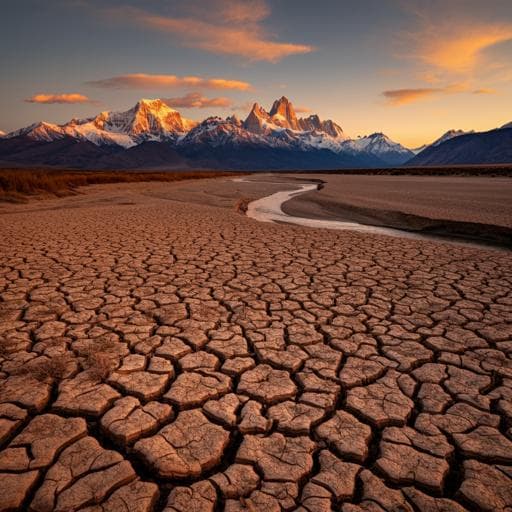
Earth Sciences
Winter snow deficit was a harbinger of summer 2022 socio-hydrologic drought in the Po Basin, Italy
F. Avanzi, F. Munerol, et al.
This study reveals how a high-pressure ridge led to a staggering 88% anomaly in peak snow water equivalent in the Po basin, Italy, during winter 2022. The research, conducted by Francesco Avanzi and colleagues, connects the dots between snow droughts, low terrestrial water storage, and emergency water restrictions, underscoring the crucial role of snowmelt in socio-hydrologic droughts.
~3 min • Beginner • English
Introduction
Snow acts as a seasonal buffer that stores winter precipitation and releases it as melt during spring and summer when water demand peaks. Declining snow cover and increasing drought intensity under climate change threaten water security for mountain and downstream lowland populations. Snow droughts—periods with below-average snowpack due to reduced precipitation and/or warmer temperatures—have intensified and are projected to become more frequent, often featuring rain-on-snow events and early melt. Prior droughts have shown cascading impacts from snowmelt deficits to water scarcity and emergency restrictions, yet the mechanistic links from headwater snow deficits to lowland socio-hydrologic impacts remain underexplored. This study addresses three questions: (i) the extent to which snow droughts affect terrestrial water storage beyond streamflow deficits; (ii) the role of snowmelt deficit versus low SWE in driving water-supply anomalies; and (iii) whether the spatial and temporal patterns of snowmelt deficit shape the escalation of socio-hydrologic impacts. Focusing on the 2021–2022 drought across the Po River basin, Italy, the authors combine snow and climate reanalyses with terrestrial water storage, streamflow, and municipal emergency water-use restriction data to trace how an anomalously dry and warm winter translated into unprecedented hydrologic and governance impacts across elevations and regions.
Literature Review
The paper synthesizes prior work showing snow’s critical role in water supply for mountain and downstream populations and documents widespread declines in snow cover and SWE across mountain regions, including the European Alps. It distinguishes cold versus warm snow droughts and notes observed intensification since 1980, with projections of increased frequency under warming and exacerbation by early melt and rain-on-snow. Previous studies highlight how snowmelt deficits propagate to reduced streamflow and water scarcity, but mechanisms linking headwater snow deficits to lowland socio-hydrologic impacts remain insufficiently characterized. Additional literature shows long-term declines in Alpine snowpack, changes in runoff seasonality, enhanced evapotranspiration during European droughts, and multi-decadal declines in terrestrial water storage in various regions, providing context for interpreting the 2022 Po basin event and its broader implications for drought risk and management in snow-dominated systems.
Methodology
Synoptic circulation: The authors analyzed ERA5 reanalysis (hourly, ~30 km) to characterize December–February (DJF) 2021–2022 anomalies in 500-hPa geopotential height, mean sea-level pressure, 2-m air temperature, and cumulative precipitation across Europe. Dimensional anomalies (X' = X_2021–2022 − X_1991–2020) and percentage anomalies X_an(%) = [(X_2021–2022 − X_1991–2020)/X_1991–2020]×100 were computed using the 1991–2020 climatology. For comparisons with SWE and other hydrologic anomalies, the reference period was restricted to 2011–2021, and monthly anomalies were computed where relevant.
Snow water equivalent (SWE) and snowmelt: Spatial SWE estimates came from S3M Italy within the IT-SNOW reanalysis (open-source, 500 m resolution), which blends a distributed physics-based snow–glacier model with assimilation of in-situ snow depth (300+ ultrasonic sensors, 800+ manual surveys) and satellite snow-covered area (Sentinel-2, MODIS, EUMETSAT H SAF). The IT-SNOW period (Sept 2010–Aug 2021) was extended through Aug 2022. March 6 was used as the conventional peak SWE date. The team computed (i) spatially distributed March-6 2022 SWE anomalies against 2011–2021; (ii) seasonal trajectories of spatially integrated SWE for the Po basin across five elevation bands (500–1000, 1000–1500, 1500–2000, 2000–2500, 2500–3000 m a.s.l.) for 2010–2011 through 2021–2022; (iii) snowmelt as day-to-day SWE differences and monthly snowmelt anomalies vs. 2011–2021; and (iv) annual anomalies of upstream March-6 SWE for 38 Po sub-basins (2011–2021 reference). Note: Canton Ticino (≈5% of basin) was excluded due to data limitations, expected to have marginal impact.
Terrestrial water storage (TWS) and streamflow: TWS anomalies were derived from GRACE/GRACE-FO JPL Mascon RL06.1Mv03 products (monthly; anomalies relative to 2004–2009 mean), spatially averaged over mascons intersecting a bounding box covering the Po basin (44.25–46.25°N, 7.25–12.25°E) to capture regional groundwater flow paths potentially extending beyond surface divides. Streamflow: daily discharge for the Po at Pontelagoscuro (1923–2022) was compiled from Annali Idrologici (Emilia-Romagna). For 38 river sections, annual anomalies of cumulative streamflow (September–August hydrologic year) for 2010–2011 through 2021–2022 were computed using regional hydrometeorological datasets, with 2011–2021 as reference.
Emergency water-use restrictions: An inventory of 886 municipal “ordinanze sindacali” was compiled for Piemonte, Valle d’Aosta, and Lombardia through a hierarchical search (regional authorities, water management agencies, municipal repositories, direct contacts, media). Each restriction’s publication date and location were recorded. Monthly counts were compared against monthly anomalies in precipitation (ERA5), snowmelt (IT-SNOW by elevation bands), and streamflow (Pontelagoscuro). Spatial patterns of restrictions (spring, early summer, late summer 2022) were compared to March-6 SWE deficits. The analysis examined synchronicity between peaks in hydrometeorological anomalies and governance responses.
Key Findings
- Synoptic drivers: A persistent high-pressure ridge (DJF 2021–2022) produced strong positive anomalies in 500-hPa geopotential height (~7.5 dam) and sea-level pressure (~4.4 hPa) over western Europe, with widespread winter precipitation deficits (up to −70% regionally) and positive air temperature anomalies across 30–60°N.
- SWE deficit magnitude and homogeneity: The Po River basin exhibited the most intense SWE anomaly, with a basin-average March-6 2022 SWE deficit of −88% ± 24% vs. 2011–2021, and widespread deficits < −70% across much of the Italian Alps.
- Winter SWE dynamics: SWE was quasi-stationary during mid-winter 2021–2022, reflecting the balance of sparse snowfalls and frequent mid-winter melt episodes under warmer conditions. DJF mean-temperature anomalies increased with decreasing elevation (+0.18 °C at 2500–3000 m to +0.53 °C at 500–1000 m), while DJF cumulative precipitation anomalies ranged from −54% to −38%, with larger deficits at lower elevations. SWE deficits exceeded precipitation deficits at all elevation bands.
- Earlier melt-out: Melt-out (defined at 2% of median historical peak SWE for each elevation) occurred 97, 24, 21, 27, and 49 days earlier (2011–2021 reference) for 500–1000, 1000–1500, 1500–2000, 2000–2500, and 2500–3000 m, respectively. Early melt-out at high elevations was likely accelerated by a May heatwave (ERA5 anomaly ~+2.6 °C at 2500–3000 m).
- Terrestrial water storage: GRACE showed the lowest winter maximum in early 2022 of the 2002–2022 record, comparable to historical summer minima, followed by the lowest summer minimum on record. The 2022 seasonal TWS range (−16.8 cm, March–August) was only slightly larger than the long-term mean (−15.5 ± 4.5 cm), indicating the antecedent winter minimum as a key contributor to the unprecedented summer low. A statistically significant declining multi-decadal TWS trend was detected, with 2021–2022 consistently below the 2002–2021 first quartile.
- Streamflow deficits and coupling with SWE: At Pontelagoscuro, August 2022 registered the historical minimum daily discharge in the 1923–2022 record. Across 38 sections (2011–2021 reference), median anomalies were −20% (streamflow) and −46% (SWE) in 2012, −27% and −40% in 2017, and −58% and −82% in 2022. In headwater, unnested basins the anomalies were more severe: −30% (Q) and −46% (SWE) in 2012, −32% and −71% in 2017, and −70% and −92% in 2022, indicating intensification of coupled snow–streamflow droughts.
- Climatic compounding in summer: ERA5 shows JJA 2022 temperature anomaly of +1.9 °C (larger than DJF), and a smaller JJA precipitation deficit (−10%) vs. winter deficits (−54% to −38%), underscoring roles of antecedent snow deficit and enhanced evapotranspiration in the summer low flows, with a smaller direct contribution of summer precipitation deficit.
- Socio-hydrologic impacts: Emergency water-use restrictions (886 ordinances; affecting >6.1 million people) peaked in June 2022, coincident with the month of maximum snowmelt deficit across elevations, not with the winter precipitation minimum (January 2022). Mid-winter positive snowmelt anomalies (from warmth-induced melt episodes) partially mitigated winter flow deficits but exacerbated June deficits.
- Spatial evolution of restrictions: Early restrictions (Mar–May) were concentrated in headwaters (spring-fed supplies with low resilience). Peak restrictions (Jun–Jul) occurred in lowlands, coinciding with the missed freshet critical for surface irrigation. In August, restrictions shifted back toward mountain regions, consistent with earlier melt-out and exacerbated late-summer low flows.
- Glacier melt compensation: Preliminary estimates suggest glacier melt contributed ~3% of annual streamflow basin-wide (Sep 2021–Aug 2022) but ~17% in August 2022, offering partial headwater compensation for missing snowmelt, diminishing with increasing spatial scale and flowpath complexity.
Discussion
The study demonstrates that the 2021–2022 snow drought in the Po basin generated a cascade from exceptional winter SWE deficits to unprecedented declines in terrestrial water storage and historic streamflow lows, culminating in widespread municipal water-use restrictions. The timing and geography of socio-hydrologic impacts tracked the evolution of snowmelt deficits rather than winter precipitation anomalies, highlighting snowmelt’s central role in sustaining water supply in mixed rain–snow basins. Elevation-dependent vulnerabilities emerged: low elevations experienced conditions unsupportive of seasonal snowpack formation; intermediate elevations saw smaller anticipations of melt-out; and high elevations faced pronounced earlier melt-out driven by spring warmth. These differences imply the need for elevation-specific adaptation strategies, recognizing that peak SWE controls summer volumes while melt-out timing governs freshet timing and ecosystem services. The observed multi-decadal TWS decline suggests that future snow droughts may increasingly coincide with reduced storage buffers, amplifying summer low flows and undermining resilience. The clear lead–lag relationship between winter SWE signals and summer governance responses indicates a practical pathway for early-warning systems that leverage real-time SWE estimation and high-resolution modeling to anticipate socio-hydrologic drought escalation and support proactive management.
Conclusion
The paper identifies antecedent winter snow deficits—and the resulting snowmelt shortfalls—as key aggravating drivers of the summer 2022 socio-hydrologic drought in the Po River basin. It quantifies unprecedented SWE and TWS anomalies, documents historic streamflow lows, and shows that emergency water-use restrictions coincided with peak snowmelt deficits. Elevation-dependent impacts on peak SWE and melt-out timing underscore the need for altitude-tailored mitigation and adaptation. The findings advocate for seasonal early-warning systems that monitor and forecast SWE and snowmelt at high resolution, integrating satellite retrievals and hyper-resolution models to anticipate downstream socio-hydrologic impacts. Given ongoing warming, rising evapotranspiration, and declining terrestrial water storage, future work should refine coupled human–natural system data (e.g., water abstractions), improve glacier–snow process representation, and operationalize SWE-informed drought risk forecasting to bolster water governance and resilience.
Limitations
- Attribution complexity: In a mixed rain–snow, heavily managed system, disentangling the effects of missed snowmelt from enhanced evapotranspiration, precipitation deficits, and irrigation is limited by the lack of high-resolution data on water abstractions and uses.
- Spatial coverage: SWE reanalysis excludes Canton Ticino (~5% of the basin), though expected to have marginal overall impact; GRACE mascons include areas outside the surface basin to account for uncertain groundwater flow paths, introducing spatial averaging beyond basin limits.
- Data/model constraints: GRACE provides coarse (~300–400 km) monthly TWS anomalies relative to a time-mean (no absolute climatology). The glacier model component is simplified (no ice dynamics/mass balance), so glacier melt contributions are preliminary. Streamflow records are locally/seasonally affected by anthropogenic processes (e.g., irrigation), and robust correction methods are still emerging.
- Reference periods: Several anomaly computations use 2011–2021 as the reference, which overlaps with analyzed years (except 2022), potentially affecting anomaly magnitudes but chosen for consistency across variables.
- Socio-hydrologic dataset completeness: The inventory of 886 municipal emergency water-use restrictions, though extensive, is likely non-exhaustive due to the absence of a centralized database and reliance on multiple heterogeneous sources.
Related Publications
Explore these studies to deepen your understanding of the subject.







